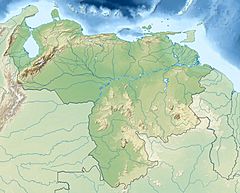Pristimantis avius facts for kids
Pristimantis avius is a special kind of frog that belongs to the family called Strabomantidae. This frog is only found in Venezuela, a country in South America. So far, scientists have only seen it in one specific place: at the northern base of Pico Tamacuari, which is a mountain in the Sierra Tapirapecó area of Amazonas state.
Quick facts for kids Pristimantis avius |
|
|---|---|
| Conservation status | |
| Scientific classification | |
| Synonyms | |
|
Contents
What's in a Name?
The name avius comes from a Latin word that means "out of the way" or "remote." This name was chosen because the only place this frog has ever been found is a very remote and hard-to-reach area.
Meet the Pristimantis avius Frog
Scientists have studied a few of these frogs, including three adult males, two adult females, and three young frogs. Adult males are about 20 to 24 millimeters (0.8 to 0.9 inches) long from their snout to their bottom. Females are a bit bigger, measuring about 31 to 33 millimeters (1.2 to 1.3 inches).
Physical Features
The frog's head is usually as wide as or wider than its body. Its snout can be slightly rounded or bluntly pointed when you look from above. The tympanum, which is like its eardrum, is easy to see and looks round or slightly oval.
The fingers and toes of Pristimantis avius have wide tips, but they don't have any webbing between them. The skin on the frog's back is bumpy.
Color and Pattern
The color of these frogs can change a lot! They can be orangish-brown, brown, tan, or even greenish-brown. Some frogs have stripes on their back that are grayish-brown or brown. One frog even had a tan line running down its back.
Some frogs have vague blotches or chevron shapes (like a "V" or "W"). Young frogs and some adults have black bumps on their shoulders. The sides of their bodies often have grayish-brown or brown bands or spots on a pale orangish-brown background. The underside of the frog is usually yellow or orange.
Reproduction and Eggs
Scientists don't know what the male frog's mating call sounds like. However, one female frog (33 mm long) was found with a much smaller male (20 mm long) in a mating embrace called amplexus.
Later, this female laid 18 eggs. These eggs were quite large, about 4.5 to 5.0 millimeters (0.18 to 0.20 inches) across, including their jelly-like coating. Without the jelly, the yolk inside was about 3.6 to 4.1 millimeters (0.14 to 0.16 inches).
Where They Live and How They're Protected
This frog lives in mountain forests called "tepui" forests. These forests are found at high elevations, between 1,160 and 1,460 meters (3,800 to 4,790 feet) above sea level.
Pristimantis avius is a terrestrial animal, meaning it lives on land. It is also nocturnal, which means it is active at night. Scientists have found these frogs at night on low plants.
Good news! There are no major known threats to this frog species right now. It lives inside the Parima Tapirapecó National Park, which helps protect its home.
See also
 In Spanish: Pristimantis avius para niños
In Spanish: Pristimantis avius para niños



